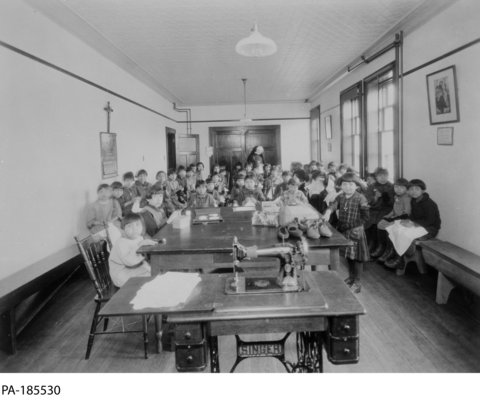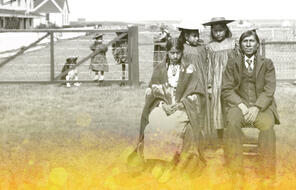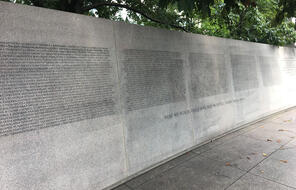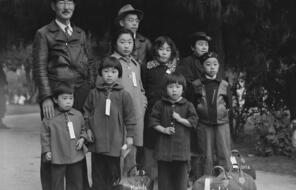Schedule and Discipline
European ideas of discipline were a central component of the Indian Residential Schools. Often, Europeans viewed Indigenous Peoples as lacking the discipline to make a decent living. To this day, a common insulting stereotype of Indigenous Peoples is that they are lazy (see reading, Culture, Stereotypes, and Identity). Historically, European notions of hard work and discipline have been closely associated with the ideas of independence, individualism, and self-sufficiency (see reading, Curriculum). 1 Indeed, the prevailing belief among Euro-Canadians was that if people worked hard enough, they would succeed in life, and that failure to do so was a sign of poor discipline. But most failed to recognize the ways in which the colonial policies, discrimination, and lack of any meaningful investment in the reserves had negatively impacted the prosperity of the Indigenous Peoples of Canada. Indeed, many Europeans believed Indigenous values needed to be eradicated and replaced with Western ways.
Girls attending the residential schools received training in domestic skills such as sewing and needlework. Here, Mi’kmaq girls are in a sewing class at Shubenacadie Indian Residential School in Nova Scotia in 1929.
Because money was limited and students’ labour was vital, many residential schools taught only half days. Daily life consisted of prayers and lessons for half the day, generally in the mornings. In the second half of the day, boys were trained in farming and basic crafts. Girls received instruction in domestic skills, very frequently sewing and mending their own clothes. In addition, students were assigned chores such as milking cows, collecting eggs, cutting and splitting firewood, picking fruit, and doing kitchen work. All activities, from the time the students woke up to the time they went to sleep, were directed by a bell. This system of discipline and surveillance at the residential schools starkly contrasted with the traditional education methods of the Indigenous communities, in which discipline was indirect and non-coercive. Use of textbooks, memorization, and formal teaching also contrasted with Indigenous oral tradition and learning methods, which emphasized learning from experience and from the wisdom of elders and other community members. 2
Also in contrast to the traditional ways of life, in which people’s chores were tied to the seasons and concrete communal needs (such as hunting and harvesting, which had to be performed at specific times), the residential schools enforced a harshly methodical schedule. In 1851, Samuel Rose, a principal at the Methodist Mount Elgin Residential School in Ontario, explained the schedule in his school:
Regulations. – The bell rings at 5 A.M. when the children rise, wash, dress and are made ready for breakfast. At half-past-five they breakfast; after which they all assemble in the large school-room and unite in reading the Scriptures, singing and prayer. From six till nine the boys are employed and taught to work on the farm, and the girls in the house. At nine, they enter their Schools. At twelve, they dine and spend the remaining time till one in recreation. At one, they enter School, where they are taught till half-past three, after which they resume their manual employment till six. At six they sup and again unite in reading the Scriptures, singing and prayer. In the Winter season the boys are engaged in the Evening school, and the girls are taught needlework until 9, when all return to rest. They are never left alone, but are constantly under the eye of some of those engaged in this arduous work. 3
This daily schedule illustrates how students at Mount Elgin Industrial Residential School were kept on a strict schedule from the time they awoke at 5 a.m. to bedtime at 9 p.m.
Daily Schedule at Mount Elgin School, 1851
5 am
Bell rings, students rise, wash, and dress
5:30 a.m.
Breakfast, then prayers
6-9 a.m.
Boys work on farm and girls in house
9-12 p.m.
School
12-1 p.m.
Lunch and recreation
1-3:30 p.m.
School
3:30-6 p.m.
Work on farm
6 p.m.
Dinner and Prayers
Evening
In winter boys in evening school, girls learn needlework
9 p.m.
Bedtime
Source: Hope Maclean, “Ojibwa Participation in Methodist Residential Schools,” The Canadian Journal of Native Studies 25 (2005), 115.
Dorothy Day, who attended Mount Elgin from 1929 to 1930, relates what a typical morning at school looked like and describes the heavily regulated schedule the children had:
You had five minutes to get up when the first bell would ring, five minutes to get up and put your clothes on, five minutes to run two flights of stairs and be downstairs and stand in line for the second bell to go in and wash your hands and face. And that’s all they give you—five minutes to wash your hands and face and brush your teeth, and comb your hair and stand in line again. We’d be running over each other to get down those stairs—it was good exercise—no wonder nobody ever put on weight. They’d be standing at the bottom of the stairs with a watch to make sure you were down there in 5 minutes. You should see the girls coming down there—we had those boots that laced up high and they’d tie them together and lace them when they got to the bottom. If you weren’t down there—up you would go to get the strap. They would give you the strap for being late—you were supposed to be down there when you were supposed to be. 4
Finally, discipline went hand in hand with a strict schedule of religious instruction. Terry Lusty, who attended St. Joseph’s Indian Residential School from the age of three, describes it as follows:
Every morning we went to church service. Every evening was Benediction. Everyday. And with me it got to a point where I was just saturated with religion. I turned my back on it later because it was just overwhelming. You virtually lived, ate, and breathed religion. In school you had catechism. You had the Bible and the prayers and all the Latin, learning the Latin words. I can still spiel them off today, even though I haven’t used it for so many years. But don’t ask me what they mean. But as if that wasn’t enough, on top of that because I had a singing voice, I had to be part of the choir. I had to be an altar boy . . . 5
- 1See John S. Milloy, A National Crime: The Canadian Government and the Residential School System (Winnipeg: University of Manitoba, 1999), 3.
- oral tradition oral tradition: Indigenous traditions provide meaning and value to their members, connect them to past, present, and future generations, and teach them about their place in the natural world. These traditions are communicated from one generation to another by storytellers, traditional healers, group leaders, and elders, often through music, dance, and elaborate ceremonies that are referred to as oral tradition. Historically, Westerners tended to dismiss non-written cultures, such as those of the Indigenous Peoples, as inferior.
- 2Derek Smith, “The ‘Policy of Aggressive Civilization’ and Projects of Governance in Roman Catholic Industrial Schools for Native Peoples in Canada,” 260.
- 3Rev. Rose Report, 1851, in Elizabeth Graham, ed., The Mush Hole: Life at Two Indian Residential Schools (Ontario: Heffle Publishing, 1997), 227–28.
- 4Elizabeth Graham, The Mush Hole, 436.
- 5100 Years of Loss: The Residential School System in Canada, Teachers’ Guide (Ottawa: Legacy of Hope Foundation, 2011), 117.

Connection Questions
- How did the structure of the school day respond to the prejudices and stereotypes instructors at the residential schools had about Indigenous culture?
- As you read the two passages from Dorothy Day and Terry Lusty, what words stand out?
- What are the qualities of a good school? You might create a word map to record your ideas. Then create a contrasting word map based on the descriptions of the residential schools. You might want to add to it as you continue reading this chapter.
- How do these descriptions of the schedules at residential schools compare to your own school day? What is missing from the schedule at the residential school? What do you think would have been the impact of such differences on the lives of the children who attended residential schools?
How to Cite This Reading
Facing History & Ourselves, "Schedule and Discipline," last updated September 20, 2019.















